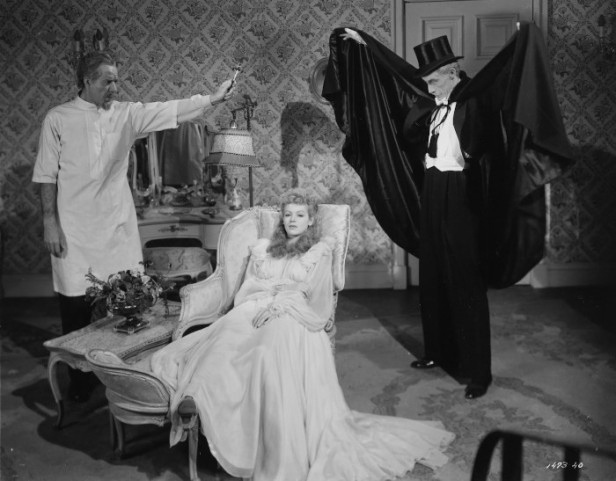Fourteen years after the double whammy of Dracula and Frankenstein, House of Dracula marked the end of the line for the serious Universal monster films, the Black Lagoon trilogy notwithstanding (they were more a product on the atom age than Gothics anyway). The moderate success of House of Frankenstein (1944) inspired Universal to try out one more monster rally, retaining the services of screenwriter Edward T. Lowe and director Erle C. Kenton. This time, Lowe manages to integrate the monster a little better but it’s still a far cry from the monsters’ glory days.
Amy attempt at continuity is abandoned from the very start as Count Dracula (again played by John Carradine in a top hat) turns up undead and well at the gates of the castle in Visaria owned by Dr Franz Edelmann (Onslow Stevens), hoping that he’ll be able to help cure him of his condition. Edelmann agrees, using his own blood to transfuse int the vampire. Later, wolf man Lawrence Talbot (Lon Chaney Jr) arrives (there’s no explanation offered as to why he’s still alive either), similarly seeking a cure and audiences will soon be getting that sinking feeling that House of Dracula is shaping up to be a rerun of House of Frankenstein. With the full moon pending, Talbot gets himself arrested so that he’s in jail when he transforms, witnessed by Edelmann and Inspector Holtz (Lionel Atwill). Edelmann and his assistants Milizia (Marta O’Driscoll) and Nina (Jane Adams) take Talbot into their care, but fearing that help will never come, Talbot attempts suicide by leaping off the nearby cliffs, washing up in a cave beneath the castle. He’s retrieved, along with the Frankenstein monster, found still clutching the skeleton of Dr Niemann. The rest of the film really does mirror that of House of Frankenstein – Dracula gets a bit more to do, trying to seduce Milizia, but is still the first to be written out, but not before transferring his own blood into Edelmann who then becomes a murderous, vampire-like creature himself; operations on Talbot are successful; the monster is revived for some last minute carnage; and the inevitable torch-wielding mod descends on the castle.

House of Dracula had begun life as The Wolf Man vs Dracula but the Count again drew the short straw and is gone before he gets a chance to make good on that title. The script is wholly derivative, Lowe not only reusing virtually the same plat as that he’d cobbled together for House of Frankenstein, but also wodges of dialogue. Viewers with good memories might even recall that in WereWolf of London (1935) there was much talk about the healing powers of a mysterious flower, a plot thread lifted wholesale for this one. There are even a few notes from the Sherlock Holmes series theme reused in the scene where Talbot attacks Edelmann in the cave and to help towards the war effort, few new sets or props were built, the majority of the film shot of sets left over from previous films.
Lowe also lacks the wherewithal to work out his own loopy pseudo-science. He tries, commendably enough, to bring a sort-of scientific rationale to the proceedings but in doing so, the characters lose something. Dracula’s condition is reduced to a disorder of the blood that Edelmann is convinced be cured by a simple transfusion, while Talbot’s condition has something to do with pressure on the brain, a condition that can be cured by liberal use of the magical plant that is, very conveniently, flowering in the caves beneath the castle. It hints at the turn towards science fiction that was to happen in the next decade, but it robs the great monsters of their Gothic mystique.

It’s all so enervating (though still the smallest of steps up from House of Frankenstein) and a sad end to the string of films that had seen many ups and downs over the years, but which had mostly been a lot of fun. But House of Dracula has a weary hand-me-down feel to it that not even a decent if hardly star-studded cast can do to save – Stevens is particularly good, despite a less than believable wig and beard combo. But Chaney had exhausted his “tortured hero” routine by now and it’s hard to care too much about his plight, even though he finally gets the happy ending he’d craved since The Wolf Man (1941).
After House of Dracula, the was really nowhere else for the classic monsters to go and the ended up in the arms of comedy duo Abbott and Costello. Their string of “meet the monsters” comedies would begin with Abbott and Costello Meet Frankenstein (1948), itself a monster rally that brought back Talbot in his werewolf form (no explanations were probably necessary for a film that had precious to do with anything that had gone before), the Frankenstein monster and Dracula, played one last time by Bela Lugosi. After doing similar jobs on the mummy, the invisible man and Boris Karloff, Universal let the monsters finally rest in peace.
House Of Dracula felt like a pinnacle for its time. It’s understandable that some comedies like the monsters meeting Abbott & Costello and particularly Young Frankenstein seemed to take over for newer material. Thanks again, Kevin, for revisiting all these classics.
LikeLiked by 2 people
I still feel this is the worst of the series, and a step down from House of Frankenstein. Monsters (including Dracula!) lining up at the Doctor’s to be cured…with the absurdity of that idea, they might has well have promoted this as a comedy.
LikeLiked by 1 person